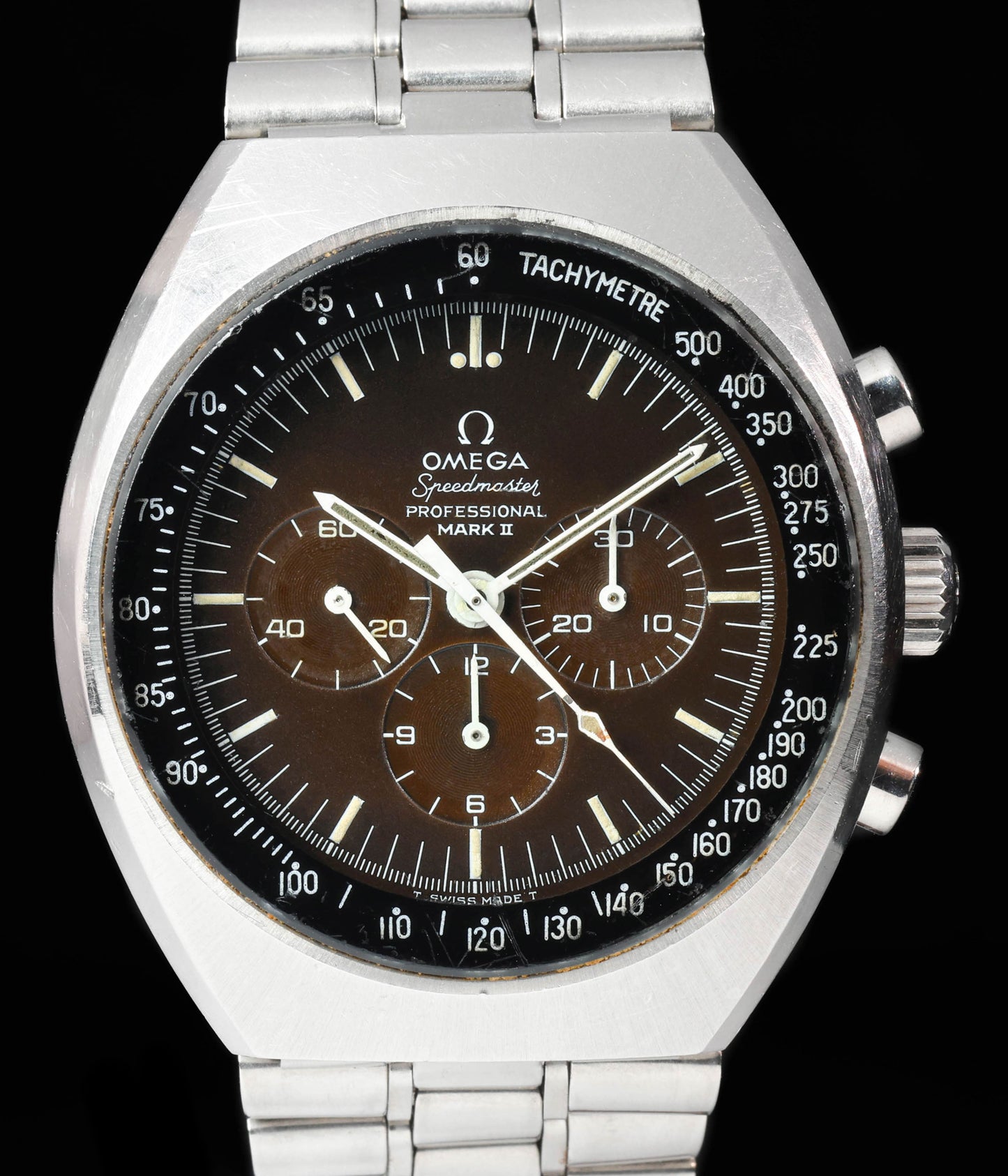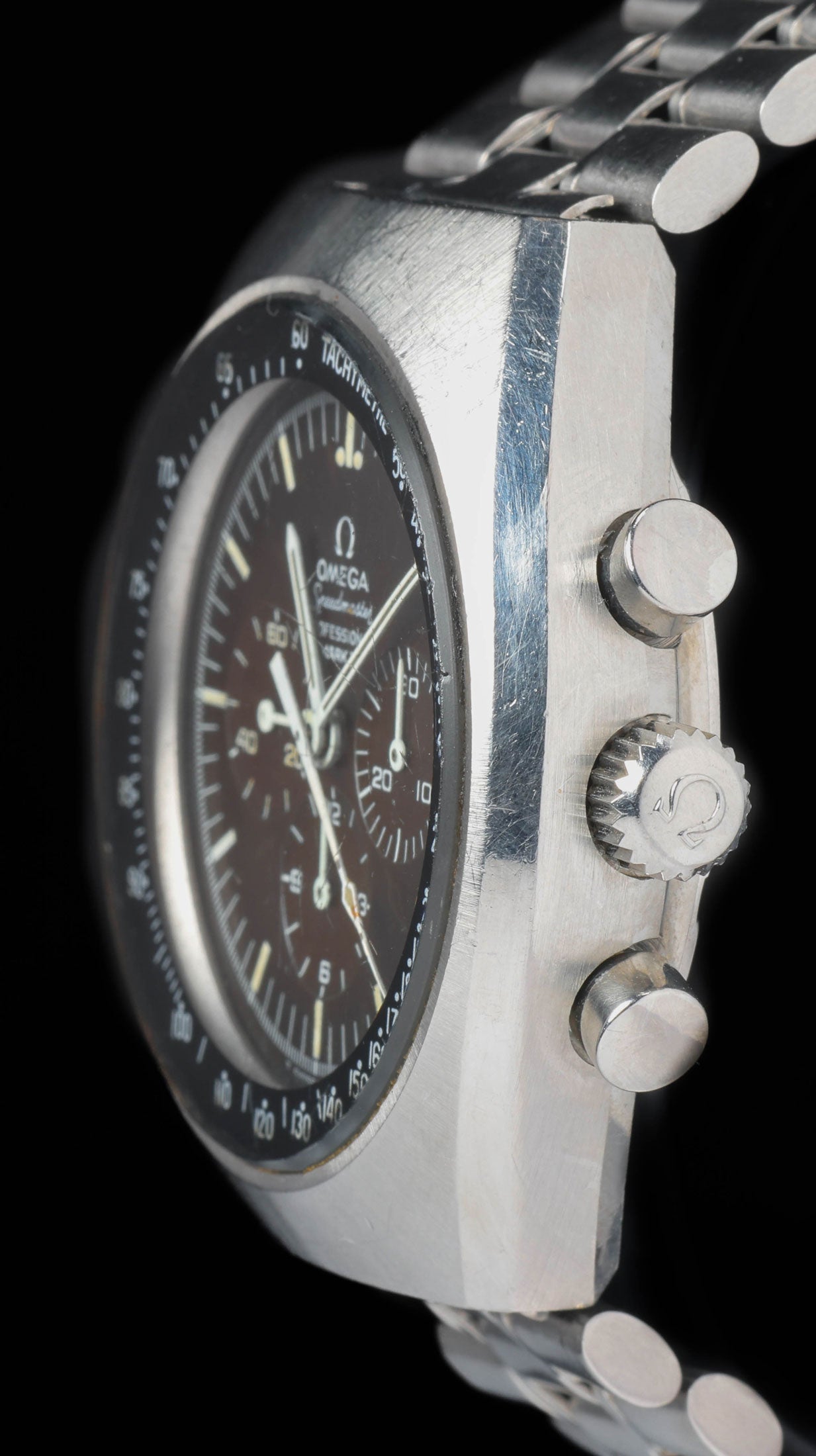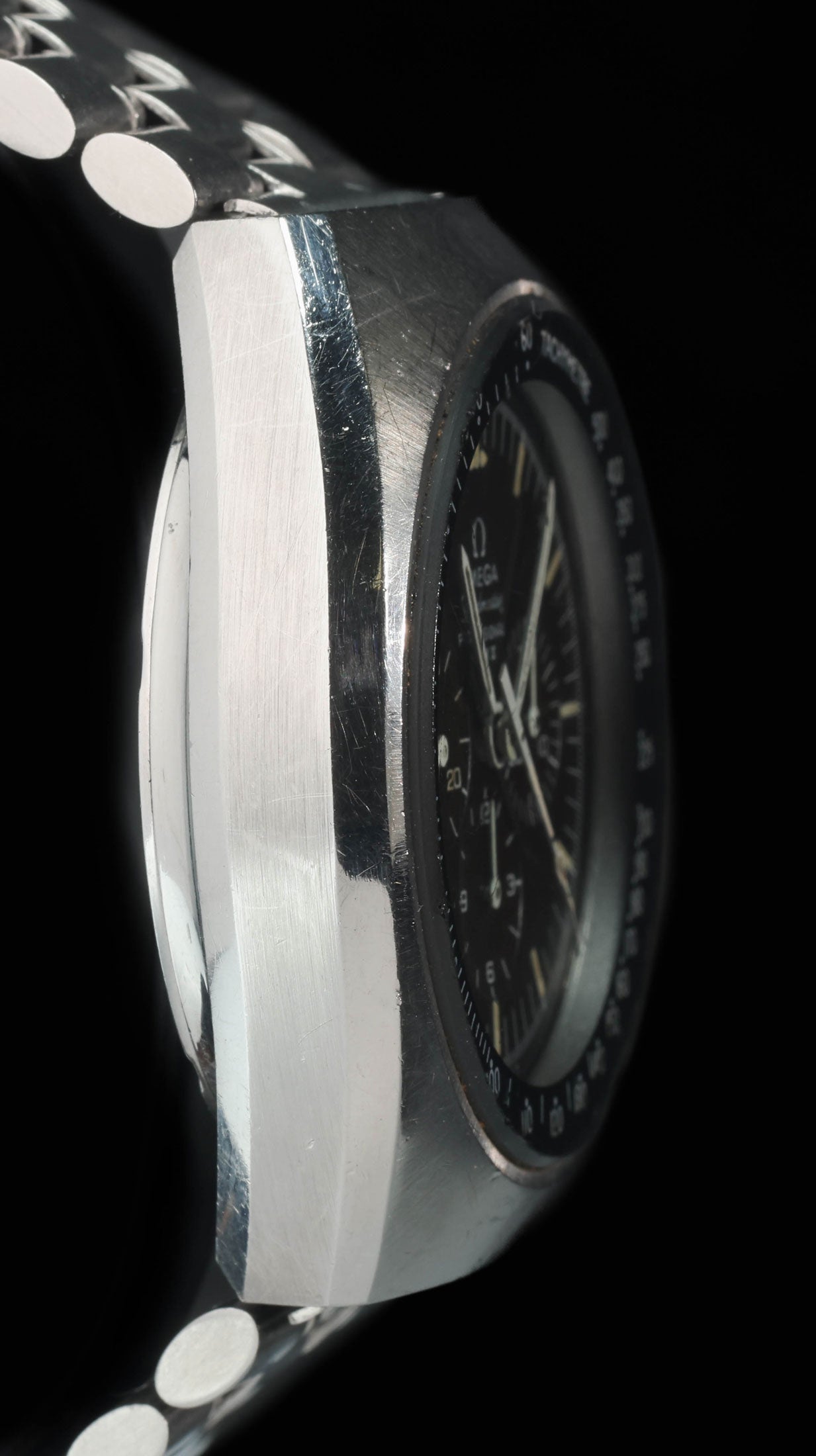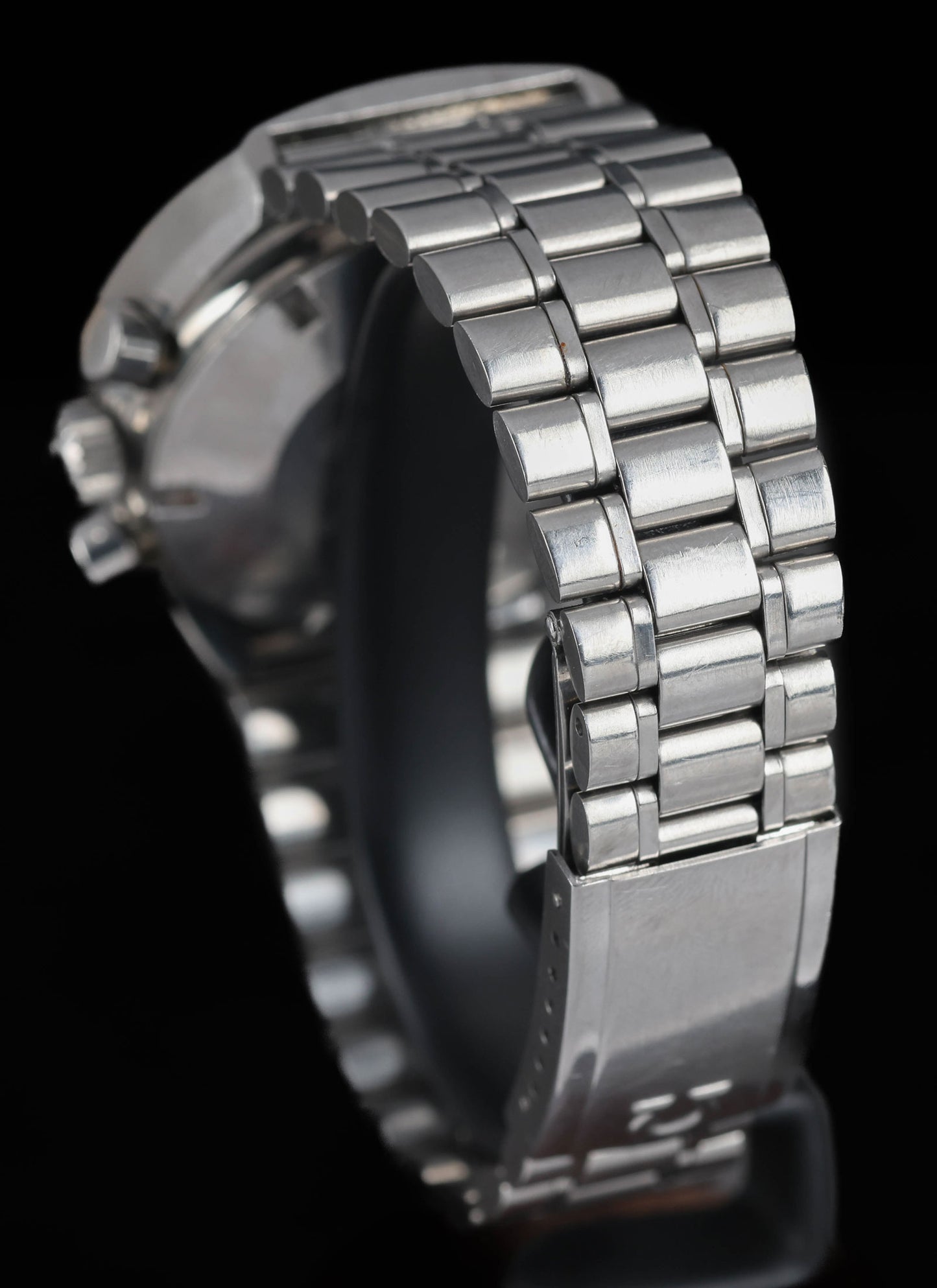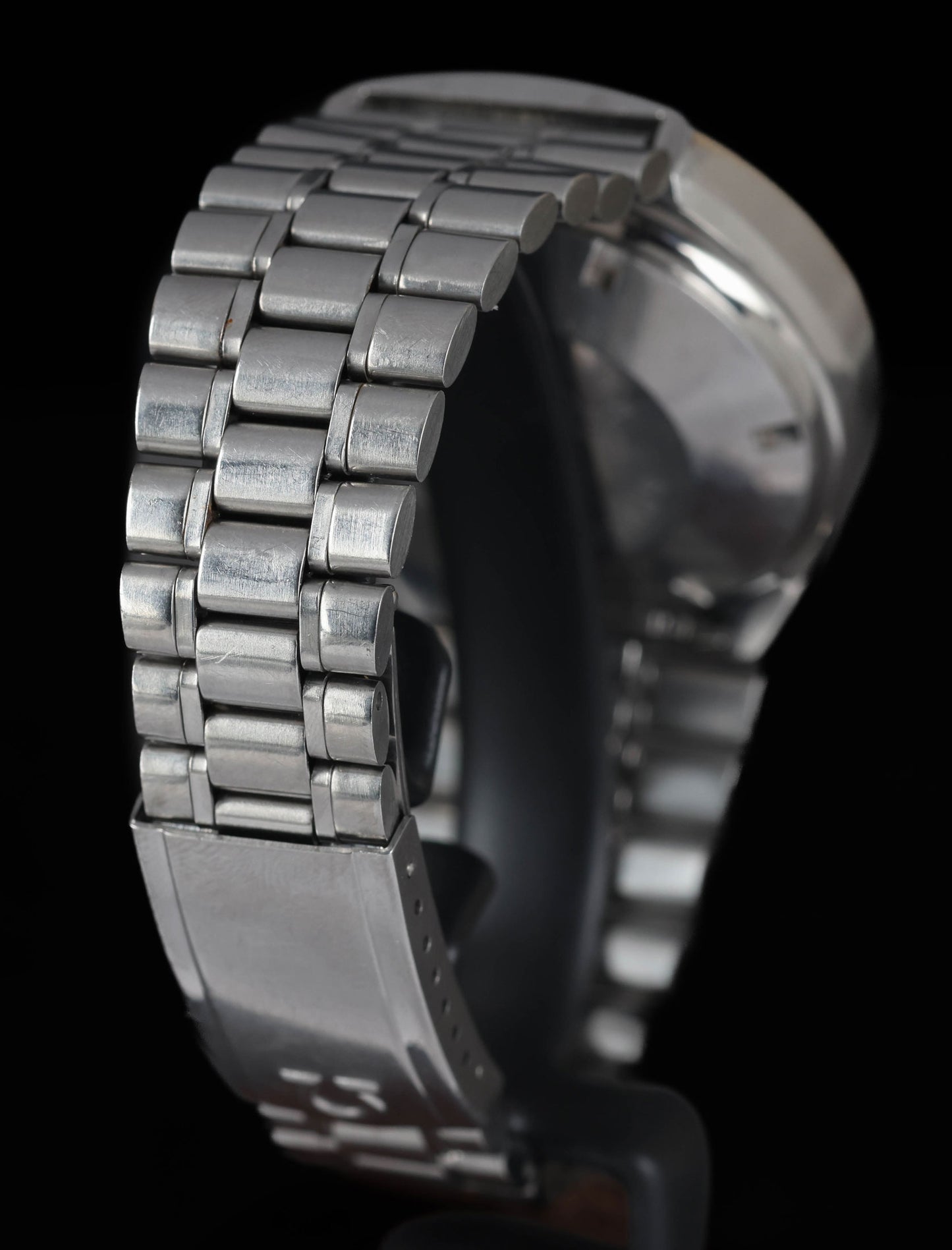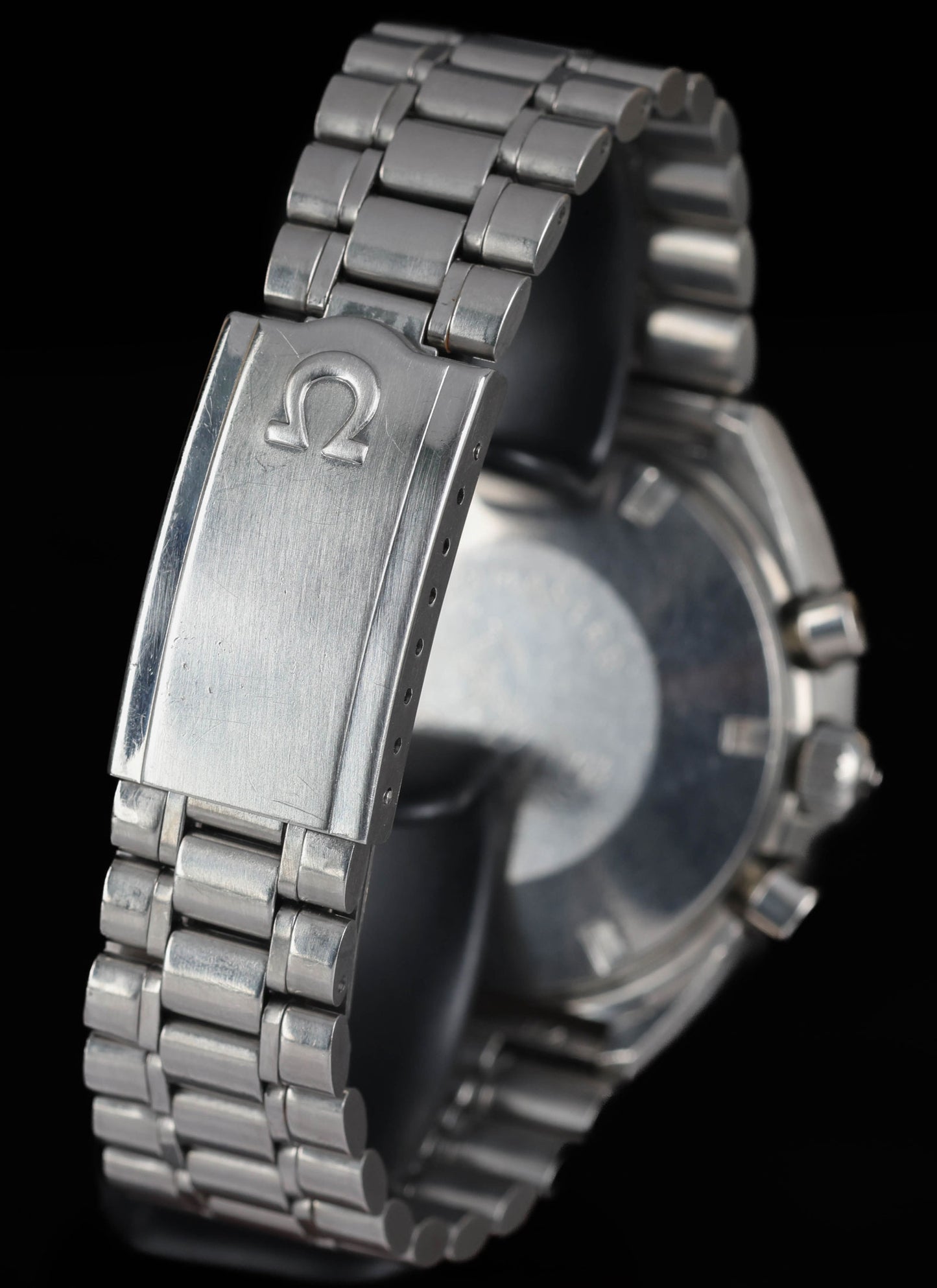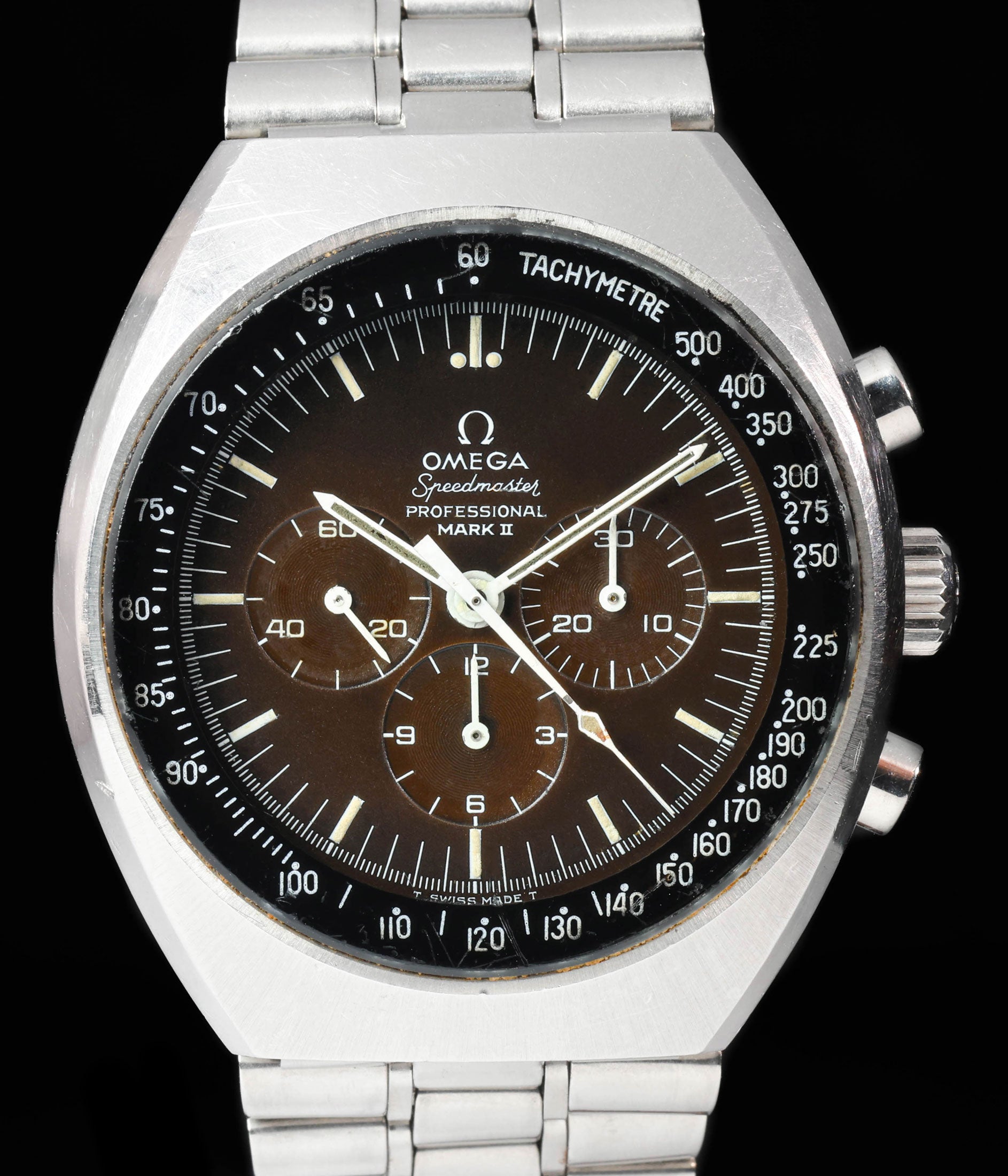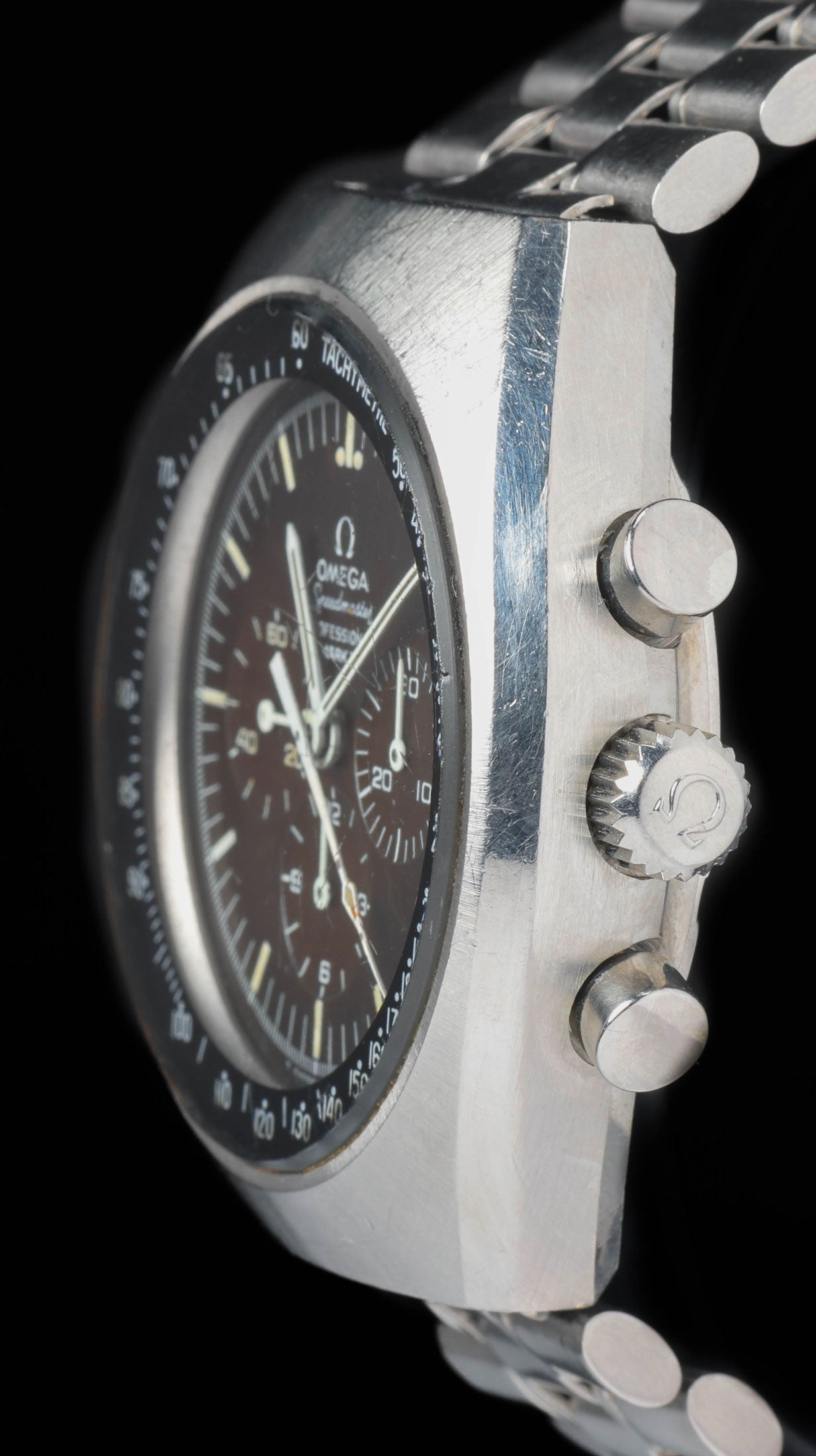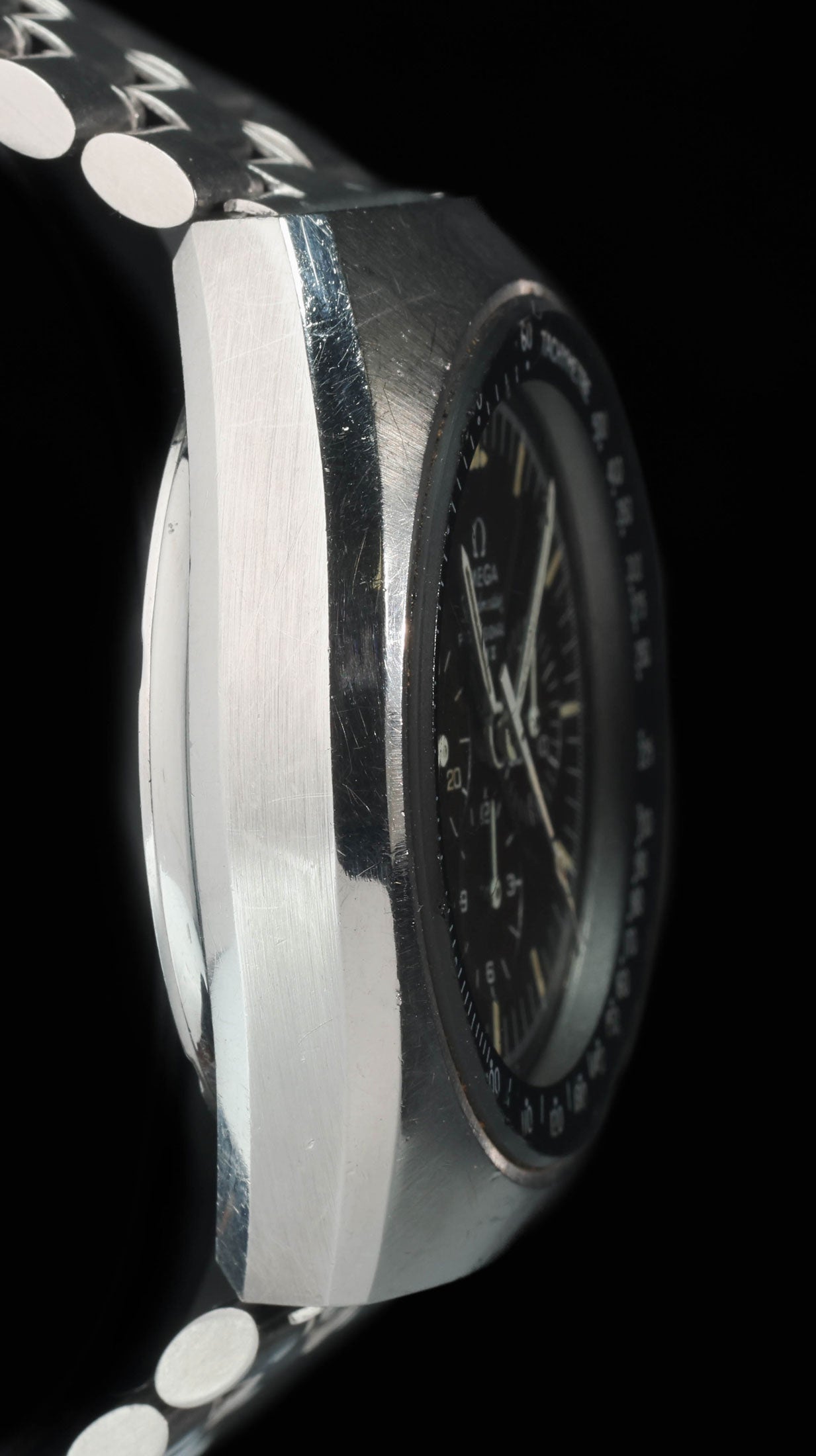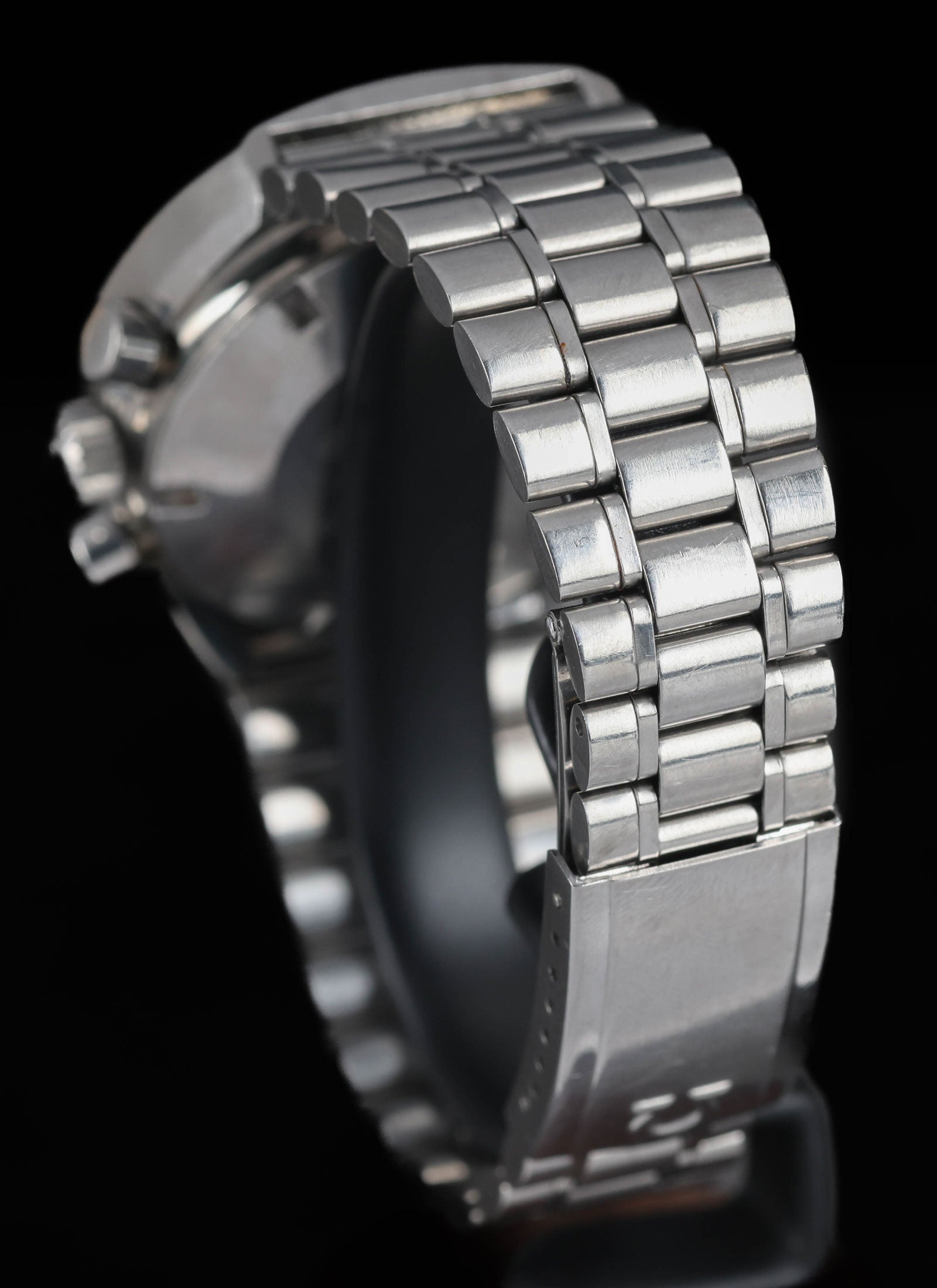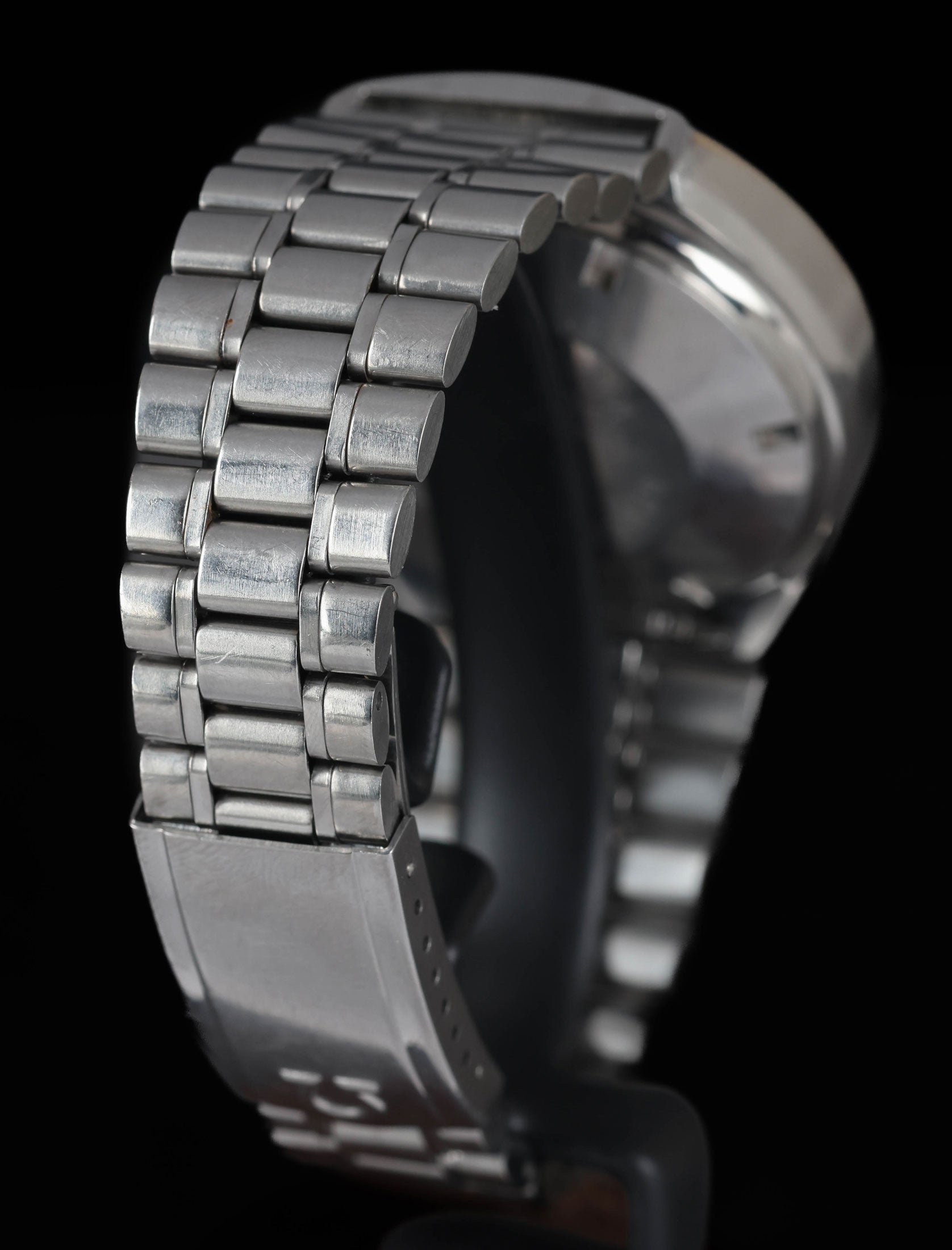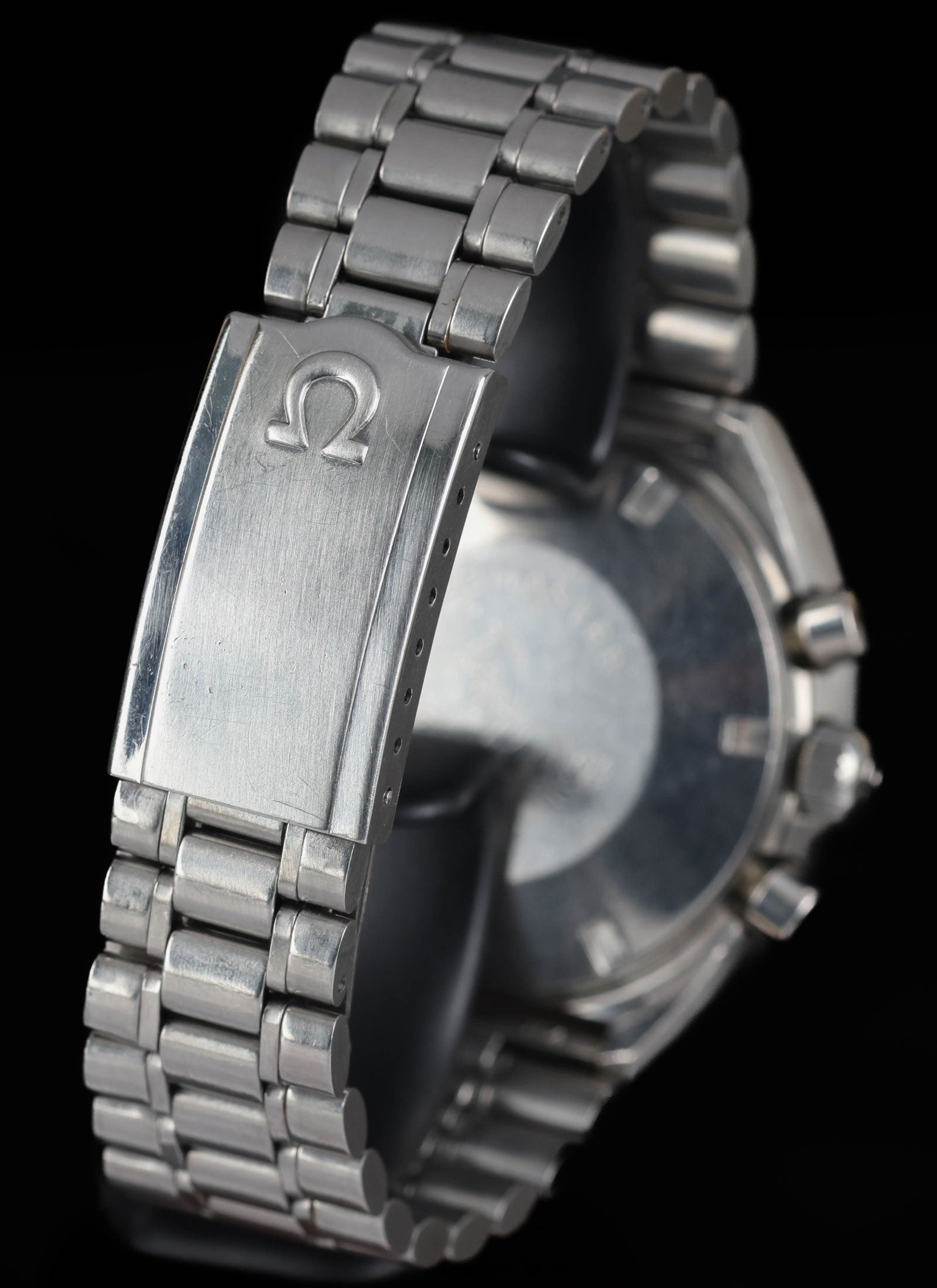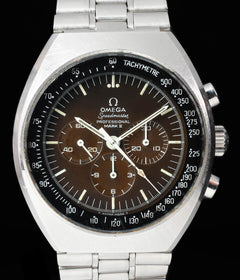Crown Vintage
Omega Speedmaster Mark II 'Tropical Dial' Ref. 145.014 42MM Circa 1973
Omega Speedmaster Mark II 'Tropical Dial' Ref. 145.014 42MM Circa 1973
Couldn't load pickup availability
Omega Speedmaster Mark II 'Tropical Dial'
Case remains in good vintage condition with honest wear visible around the sharp-edged barrel profile and bezel, consistent with age and light use. Bracelet is likewise in good vintage shape, exhibiting some stretch yet retaining solid links and secure clasp engagement. The highlight is the rich chocolate-brown tropical patina on the dial—an even, cocoa hue that contrasts cleanly with the white racing minute track and tritium hour indices—while the hands have aged to a matching tone. Crystal-printed tachymeter ring is clear and legible, and pushers operate smoothly, resetting the chronograph precisely. Crystal is in good vintage condition with some light scratches. Now more than 30 years old, this watch should be treated as a vintage timepiece—avoid swimming.
Share
Why we love this watch
Why we love this watch
Omega Speedmaster Mark II Ref. 145.014 Tropical Dial – This is the Speedmaster that Never Left Earth
Omega’s Speedmaster line debuted in 1957 as a professional racing chronograph with an external tachymeter bezel and robust manual-wind movement. By the mid-1960s the classic straight-lug and later lyre-lug Speedmaster Professional became the sole wristwatch “Flight Qualified by NASA for all Manned Space Missions” after surviving extreme temperature, shock, vacuum and vibration trials . That seal of approval catapulted the reference 105.012 to the Moon in 1969 and cemented the “Moonwatch” legend.
1969: Introducing the Speedmaster Mark II – A Bold Case for the Jet Age
Omega leveraged that lunar halo the same year with the launch of the Speedmaster Mark II. Reference 145.014 replaced the familiar 42 mm lyre-lug profile with a 41.5 mm barrel-shaped stainless-steel case whose vertical brushing, sharp chamfers and recessed crown/pusher line echoed contemporary aerodynamic design language. An integrated mineral crystal carried the tachymeter on its underside, protecting the scale from knocks that frequently chipped aluminium bezels on cockpit instrument panels.
Tropical Dial Appeal
The example shown features a rich chocolate-brown “tropical” dial—originally matte black that has aged through UV exposure and dial-lacquer chemistry into an even cocoa hue. Collectors prize this natural colour shift because it is unpredictable, irreversible and highlights the watch’s originality. The warm tone contrasts crisply with the white racing-style minute track and tritium hour indices, giving this Mark II unique visual depth under direct sunlight or studio lighting.
Calibre 861: Cam-Driven Reliability
Inside, the Mark II retained the hand-wound calibre 861 (Lemania 1873 base). Compared with the earlier column-wheel calibre 321, the cam-actuated 861 simplified servicing, raised the beat rate to 21,600 vph for smoother chronograph engagement and held a 48-hour reserve—attributes that endeared it to watchmakers and remain a cornerstone of vintage Speedmaster reliability today.
Why NASA Never Flight-Qualified the Speedmaster Mark II
Existing Certification Covered Mission Requirements
NASA’s 1965 tests had already certified the straight-lug then lyre-lug Speedmaster Professional platform. Mission planners saw no operational benefit in re-qualifying a visually different but mechanically similar chronograph when spare parts, crew training and mission simulations were calibrated around the proven reference.
Serviceability in Orbit
Mark II’s tachymeter sat beneath a sealed mineral crystal; changing the scale or replacing a cracked crystal required case disassembly and a crystal press—tools not available aboard Apollo or Skylab. The external aluminium bezel of the Moonwatch, by contrast, could theoretically be swapped with simple hand tools, matching NASA’s preference for field-serviceable kit.
Mineral Crystal vs Hesalite
NASA engineers valued Hesalite acrylic because it shatters into harmless flakes rather than sharp shards in microgravity. The Mark II’s hardened mineral glass introduced a remote but real risk of splintering under sudden impact—an unacceptable hazard inside a sealed spacecraft environment where floating debris could compromise equipment or crew.
Bulk with Space Suit Interfaces
While the barrel case improves aerodynamics on Earth, its wider lateral surfaces add millimetres under a spacesuit’s gauntlet-style glove. The slimmer lyre-lug case slipped more readily under the Apollo A7L suit’s convolute cuff, reducing interference when manipulating control panels.
Testing Resources and Mission Timelines
Re-qualification would have meant repeating thermal-vacuum, acceleration and decompression cycles—costly endeavours when budgets were tightening post-Apollo. NASA’s engineering culture dictated “if it isn’t broken, don’t fix it.” The original Speedmaster met every requirement, so resources stayed focused on life-support and guidance upgrades instead.
Dial Variants and Nicknames
Omega offered three main Mark II dial configurations: classic black, high-visibility “Racing” with orange seconds hand and segmented minute track, and a sought-after grey dial in the gold-plated case. Tropical transformations, like the deep brown specimen pictured, occur almost exclusively on early black dials and are impossible to replicate artificially without detection, bolstering authenticity.
Crystal-Integrated Tachymeter: Legibility Meets Protection
Printing the tachymeter on the crystal’s inner bezel ring preserves the scale’s crispness decades later. The white numerals sit millimetres above the pointer tips, creating a depth-effect that reduces parallax error when reading average speed. This innovation foreshadowed modern sapphire-glass rehaut designs but remained an Omega speciality in 1969.
Case Construction and Finishing
The 41.5 mm tonneau case uses a single stamped midsection with screwed-in case-back. Vertical brushing runs top-to-bottom, interrupted by polished bevels that frame the profile. This finishing method hides desk-diving scuffs yet reflects ambient light at sharp angles, emphasising the tool-watch character without unnecessary ornament.
Bracelet Integration and Daily Wear
Flat-link reference 1162/173 steel bracelets taper smoothly from 22 mm to 16 mm, delivering a snug, rattle-free fit. The low-slung case-back allows the centre of gravity to hug the wrist, preventing the pendulum effect common to taller Moonwatch references. Push-button clasp adjustment supports quick micro-sizing during Australia’s humid summers when wrists expand slightly.
Collectability and Market Interest
Interest in Mark II references has risen steadily as early Moonwatch prices soar. Buyers value the shared calibre 861 architecture, space-era provenance and striking case silhouette. Tropical dials and racing variants command premiums, especially when paired with original mineral crystals free of cracks and bracelets showing minimal stretch.
Modern Re-Issues and Ongoing Legacy
Omega revived the Mark II silhouette in 2014, adding a Co-Axial 3330 automatic movement, Super-LumiNova-filled tachymeter and sapphire crystal. That homage reintroduced the cushion case to a new audience, yet vintage purists still gravitate to hand-wound originals for their period-correct feel and direct lineage to late-sixties watchmaking.
Final thoughts
The Omega Speedmaster Mark II Ref. 145.014 stands as a snapshot of Omega’s push towards modernity at the close of the 1960s. A barrel case, crystal-protected tachymeter and rugged calibre 861 gave the watch contemporary flair, while the tropical dial on this example adds a layer of organic beauty that only decades can paint. NASA never revisited qualification because the original Moonwatch already satisfied mission parameters, yet the Mark II delivered technical refinement for earthbound pilots, drivers and timing professionals. Today it offers a compelling blend of space-era provenance, distinctive design and collectable dial patina—proof that not every chapter of the Speedmaster story needed to leave Earth to make history.
Case & Bracelet
Case & Bracelet
Case in good vintage condition, signs of wear around the case are visible. Crystal exhibits visible scratches.
Bracelet in good vintage condition, some stretch visible.
Dial & Hands
Dial & Hands
Dial & hands in good condition with pronounced tropical patina.
Warranty & Condition
Warranty & Condition
Crown Vintage Watches provides a minimum 3-month mechanical warranty on pre-owned watches, from the date of purchase.
The warranty covers mechanical defects only.
The warranty does not cover damages such as scratches, finish, crystals, glass, straps (leather, fabric or rubber damage due to wear and tear), damage resulting from wear under conditions exceeding the watch manufacturer’s water resistance limitations, and damage due to physical and or accidental abuse.
Please note, water resistance is neither tested nor guaranteed.
Shipping and insurance costs for warranty returns to us must be covered by the customer. Returns must be shipped via traceable courier. Return shipment must be pre-paid and fully insured. Collect shipping will be refused. In case of loss or damages, the customer is liable.
Our Pledge
At Crown Vintage Watches, we stand by the authenticity of every product we sell. For added peace of mind, customers are welcome to have items independently authenticated at their own expense.
Condition
Due to the nature of vintage timepieces, all watches are sold as is. We will accurately describe the current condition and working order of all watches we sell to the best of our ability.
Shipping & Refund
Shipping & Refund
